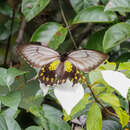Biology
provided by Arkive
Little has been documented on the biology of this species, but there are certain biological characteristics known to be common to most, if not all, birdwing butterflies. After mating, females immediately seek out appropriate host plants on which to lay their eggs, usually on plants of the genera Aristolochia and Pararistolochia (both in the family Aristolochiaceae), on which the caterpillar larvae subsequently feed (6). Once the caterpillars hatch, they voraciously munch through the leaves around them. Feeding upon these plants also serves as a defensive mechanism, as they contain certain chemicals that make the caterpillars toxic and therefore unpalatable to most predators (7). The caterpillars eventually pupate and undergo metamorphosis into adult butterflies, and may even manage to maintain toxic chemicals in their tissues into adulthood (7). Troides birdwings typically pupate on the twigs or stems of plants close to the larval food plant or on the food plant itself (3). Adults of this species feed on nectar of Mussaenda blossom and other flowers (5).
Conservation
provided by Arkive
This endemic butterfly is listed on Appendix II of the Convention on International Trade in Endangered Species (CITES), meaning that any international trade in this species should be carefully monitored (2). Additional protection is afforded to Troides andromache in the Kinabalu area, where it occurs within the boundaries of National Park lands around Mount Kinabalu (4) (8).
Description
provided by Arkive
Birdwings are large, tropical butterflies of the Papilionidae family and include arguably some of the most spectacular, butterfly species in the world. Troides birdwings are known for the striking contrast of their black and yellow colouration. The male of this birdwing species, Troides andromache, has yellow hindwings with black borders and veins. The forewings are primarily black, but on the underside, show whitish streaks towards the outer edge of the wing. The female can be distinguished from the male by its paler-coloured forewings, which are primarily whitish to tan-brown, and its different pattern of black and yellow on the hindwings (3).
Habitat
provided by Arkive
Native to montane forests, where it is recorded from around 1,000 to 2,900 metres above sea level (5).
Range
provided by Arkive
Troides andromache is endemic to the island of Borneo (3). There are two subspecies of this birdwing: Troides andromache andromache occurs in Sabah, and Troides andromache marapokensis occurs in northern Sarawak. The Indonesian part of the island (Kalimantan) is not well researched, and it is not known whether the species also occurs there (4).
Status
provided by Arkive
Classified as Lower Risk / Near Threatened (LR/nt) on the IUCN Red List (1), and listed on Appendix II of CITES (2).
Threats
provided by Arkive
The principal threats to Troides butterflies are deforestation and pressure from an increasing human population (4) (9). The Troides andromache population at Mount Kinabalu is under considerable threat from human 'development', and this beautiful butterfly has now sadly disappeared from many of its former localities around Mount Kinabalu, Sabah (4) (6). Little current data seems to be available on the status of this butterfly elsewhere (4).
Troides andromache
provided by wikipedia EN
Troides andromache, the Borneo birdwing , is a species of butterfly in the family Papilionidae. It is found only in Borneo.
Description
The wingspan ranges from 150 to 180 mm (female), the hindwings are discreetly scalloped. The body is black with yellow marks on the ventral abdomen. Troides andromache is sexually dimorphic.
The males have black upperside forewings. The underside of the forewings is black marked, in the postdiscal area and between the veins, with white. The hindwings are yellow with black veins and have a border of marginal black triangles.
The females have white forewings with black veins lined with grey. The black veined yellow hindwings have wide-bordered black margin and a wide submarginal formed of confluent black spots.
Subspecies
The subspecies are
-
Troides andromache andromache northern Borneo, Sabah
-
Troides andromache marapokensis Fruhstorfer, 1899 northern Borneo, northern Sarawak
-
Troides andromache nishikawai Kobayashi, 1992 western Borneo
Biology
The host plants for the caterpillar are Aristolochia - A. acuminata and A. foveolata.
Biotope
Troides andromache is found in rain forest canopy in the mountains of Borneo at an elevation of 1,000to 2,900 m.
Etymology
In Greek mythology, Andromache (/ænˈdrɒməkiː/; ancient Greek: Ἀνδρομάχη) was the wife of Hector and daughter of Eetion.
Related species
Troides andromache is a member of the Troides amphrysus species group. The members of this clade are:
See also
References
- Collins, N. Mark; Morris, Michael G. (1985). Threatened Swallowtail Butterflies of the World: The IUCN Red Data Book. Gland & Cambridge: IUCN. ISBN 978-2-88032-603-6 – via Biodiversity Heritage Library.
- D'Abrera, B. (1975) Birdwing Butterflies of the World. Country Life Books, London.
- Haugum, J. & Low, A.M. 1978–1985. A Monograph of the Birdwing Butterflies. 2 volumes. Scandinavian Press, Klampenborg; 663 pp.
- Staudinger, O. 1892 Ornithoptera andromache n. Sp. Deut. ent. Zeit. [Iris] 5:393-394.
- Kurt Rumbucher,Béla von Knötgen and Oliver Schäffler, Knötgen 1999 Part 7, Papilionidae IV. Troides II., amphrysus-group in Erich Bauer and Thomas Frankenbach Eds. Butterflies of the World. Keltern: Goecke & Evers ISBN 978-3-931374-74-7.

- license
- cc-by-sa-3.0
- copyright
- Wikipedia authors and editors
Troides andromache: Brief Summary
provided by wikipedia EN
Troides andromache, the Borneo birdwing , is a species of butterfly in the family Papilionidae. It is found only in Borneo.
- license
- cc-by-sa-3.0
- copyright
- Wikipedia authors and editors


